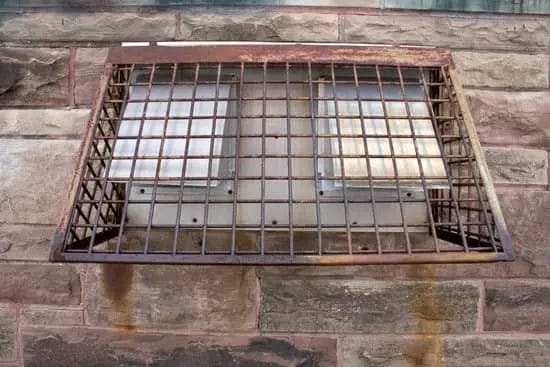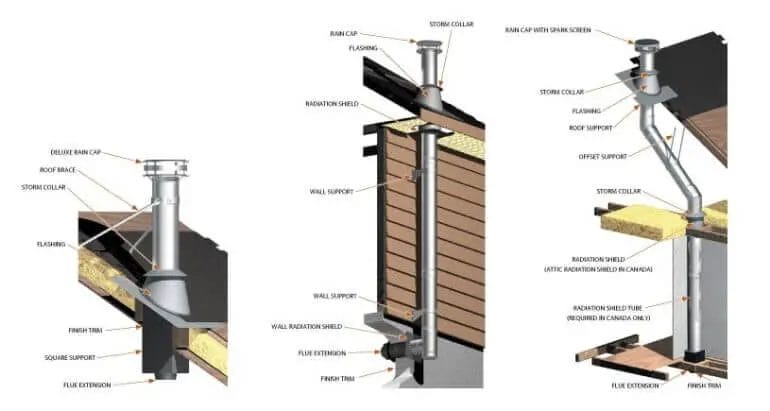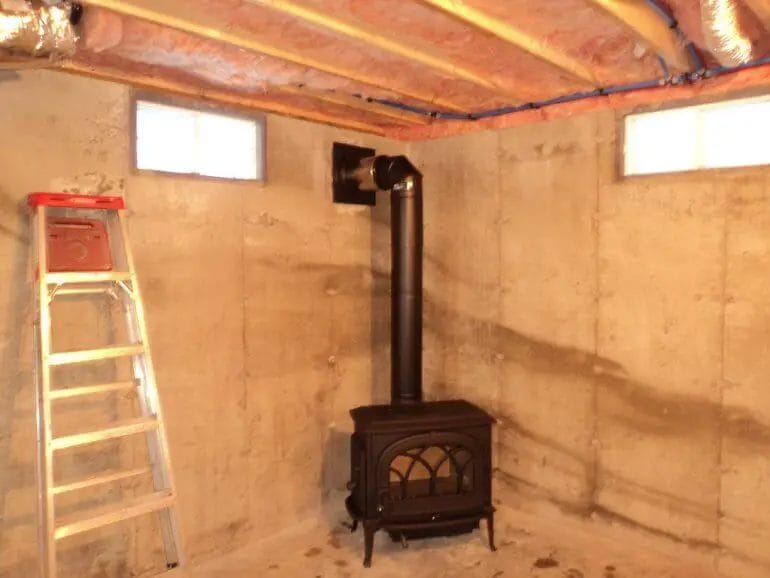If you have a wood-burning stove, proper ventilation is crucial for both safety and efficiency. When it comes to venting a wood-burning stove, there are a few key considerations to keep in mind.
Firstly, it’s essential to have a dedicated chimney or flue that is specifically designed for wood-burning stoves. This ensures that the smoke and gases produced during combustion can be safely and effectively expelled from your home.

Additionally, the chimney or flue should be properly insulated to prevent heat loss and minimize the buildup of creosote, a potentially dangerous byproduct of burning wood. Regular cleaning and maintenance of the chimney are also necessary to ensure optimal performance.
Moreover, the placement of the stove in relation to the venting system is important. The stove should be positioned near the chimney or flue to minimize the distance and maximize the efficiency of the ventilation process.
Proper installation of the venting system is critical. It should be done by a professional who is knowledgeable about local building codes and regulations to ensure compliance and safety. A well-installed venting system will provide efficient and effective ventilation for your wood-burning stove, ensuring a warm and cozy home.

Key Considerations for Venting a Wood Burning Stove
When it comes to venting a wood burning stove, there are several key considerations that should be taken into account. Proper venting is essential for the safe and efficient operation of your stove, and it plays a crucial role in maintaining good indoor air quality. In this section, we will discuss the important factors you need to consider when venting a wood burning stove.
1. Location and Clearances
The first consideration you need to address is the location of your wood burning stove and the clearances required. Stoves should be installed at a safe distance from combustible materials such as furniture, drapes, and walls. Clearances vary depending on the specific stove and the type of venting system being used, so it’s important to consult the manufacturer’s guidelines or local building codes for the exact requirements.
2. Type of Venting System
There are different types of venting systems available for wood burning stoves, including chimney venting and direct venting. Chimney venting uses a vertical chimney or flue pipe to safely exhaust the combustion gases outside. Direct venting, on the other hand, utilizes a sealed pipe system that draws in fresh air for combustion and exhausts combustion byproducts. The type of venting system you choose will depend on various factors such as your home’s layout, local regulations, and personal preferences.
3. Chimney Height and Draft
The height of your chimney plays a crucial role in ensuring proper draft and efficient operation of your wood burning stove. A chimney that is too short may not create enough draft, resulting in poor combustion and smoke accumulation in the room. It’s generally recommended to have a chimney that extends at least 3 feet above the highest point where it passes through the roof. Additionally, factors such as nearby obstructions and prevailing wind patterns should be considered when determining the optimal chimney height.
4. Chimney Maintenance
Maintaining your chimney is essential for safe and efficient venting of your wood burning stove. Regular inspections and cleanings are necessary to remove creosote buildup, which can pose a fire hazard. It’s recommended to have your chimney inspected annually by a professional chimney sweep and cleaned as needed. Additionally, installing a chimney cap can prevent debris, animals, and rain from entering the chimney, further ensuring its proper functioning.
5. Combustion Air Supply
Adequate combustion air supply is essential for efficient and clean burning in your wood burning stove. Insufficient air supply can lead to incomplete combustion, increased emissions, and decreased efficiency. To ensure proper air supply, you may need to install vents or air intakes in the room where the stove is located. These vents allow fresh air to enter the room and provide the necessary oxygen for combustion.
6. Compliance with Local Regulations
It’s crucial to comply with local regulations and building codes when venting a wood burning stove. Regulations may vary depending on your location, and they are in place to ensure the safety and well-being of occupants. Before installing a wood burning stove or making any modifications to your venting system, consult with local authorities or a qualified professional to ensure compliance with all applicable regulations.
In summary, venting a wood burning stove requires careful consideration of factors such as location, clearances, type of venting system, chimney height, maintenance, combustion air supply, and compliance with local regulations. By addressing these key considerations, you can ensure the safe and efficient operation of your wood burning stove while enjoying the warmth and ambiance it provides.

Types of Chimney Systems for Wood Burning Stoves
When it comes to installing a wood burning stove in your home, one of the most important components is the chimney system. A properly designed chimney system ensures that smoke and gases are safely and efficiently vented out of your home. There are several types of chimney systems available for wood burning stoves, each with its own set of advantages and considerations. In this section, we will explore the different types of chimney systems for wood burning stoves.
Masonry Chimneys
Masonry chimneys are the most common type of chimney system used for wood burning stoves. They are constructed using bricks, blocks, or stone and are built to withstand the high temperatures produced by the stove. Masonry chimneys offer excellent insulation and durability, making them a popular choice among homeowners.
These chimney systems are typically built during the construction of the house and require professional installation. They provide a classic and timeless look to the home and can be customized with various finishes and designs. However, masonry chimneys can be expensive to build and may require regular maintenance and repairs.
Stainless Steel Chimney Systems
Stainless steel chimney systems are another popular option for wood burning stoves. These systems are made of high-quality stainless steel and are designed to be easy to install and maintain. They offer excellent heat resistance and durability, making them a reliable choice for wood burning stoves.
Stainless steel chimney systems come in pre-fabricated sections that can be easily assembled. They are lightweight and can be installed both inside and outside the house. These chimney systems are also more affordable compared to masonry chimneys and require less maintenance.
Double-Wall Insulated Chimneys
Double-wall insulated chimneys are designed to provide increased safety and efficiency. These chimney systems have an inner stainless steel liner and an outer wall that is insulated to minimize heat transfer. The insulation helps to keep the flue gases warm, allowing for better draft and reducing the risk of creosote buildup.
Double-wall insulated chimneys are typically used when the stove is installed away from the exterior wall. They are easy to install and can be vented vertically or horizontally. These chimney systems offer enhanced performance and can be a good option for homes with specific installation requirements.
Pellet Vent Chimney Systems
If you have a pellet stove, a pellet vent chimney system is the ideal choice. These chimney systems are specifically designed for pellet stoves and provide efficient venting for the combustion gases. They are made of stainless steel and have a built-in insulation layer to maintain the optimal flue gas temperature.
Pellet vent chimney systems come in both vertical and horizontal configurations, allowing for flexible installation options. They are designed to prevent the accumulation of ash and creosote, reducing the risk of chimney fires. These chimney systems are easy to install and require minimal maintenance.
Choosing the right chimney system for your wood burning stove is essential for safe and efficient operation. Masonry chimneys offer durability and a classic look, while stainless steel chimney systems are easy to install and maintain. Double-wall insulated chimneys provide increased safety and performance, and pellet vent chimney systems are specifically designed for pellet stoves. Consider your specific needs and consult with a professional to determine the most suitable chimney system for your wood burning stove.

Step-by-Step Guide: Venting a Wood Burning Stove
Venting a wood burning stove is an essential part of the installation process to ensure the safe and efficient operation of the stove. Proper ventilation allows for the removal of smoke, gases, and other byproducts of combustion, while also preventing the buildup of dangerous carbon monoxide. In this step-by-step guide, we will walk you through the process of venting a wood burning stove, so you can enjoy the warmth and comfort it provides without any worries.
1. Determine the Type of Venting System
The first step in venting a wood burning stove is to determine the type of venting system that is best suited for your stove and home. There are two main types of venting systems: chimney venting and direct venting.
– Chimney Venting: This is the traditional method of venting a wood burning stove. It requires a masonry or metal chimney that extends above the roofline to provide proper draft and ventilation.
– Direct Venting: This method involves using a pipe that vents directly through an exterior wall. It is a more efficient and convenient option, especially for homes without a chimney or for installations on interior walls.
2. Ensure Proper Clearances
Before installing the venting system, it is important to ensure that you have proper clearances in accordance with local building codes. Clearances refer to the distance between the stove and combustible materials, such as walls, floors, and furniture.
Clearances may vary depending on the type and model of your wood burning stove, so be sure to consult the manufacturer’s guidelines and local building codes for specific requirements. It is crucial to maintain these clearances to minimize the risk of fire.
3. Install the Venting System
Once you have determined the type of venting system and confirmed the proper clearances, you can proceed with the installation of the venting system.
– Chimney Venting: If you are using chimney venting, you will need to install a chimney pipe that connects the stove to the chimney. The chimney pipe should be made of high-quality, heat-resistant materials, such as stainless steel. It should also have a minimum diameter as specified by the manufacturer.
– Direct Venting: For direct venting, you will need to install a vent pipe that extends from the stove to the exterior wall. This pipe should be insulated and sealed to prevent any leakage of combustion byproducts into your home. It is important to follow the manufacturer’s instructions for proper installation.
4. Ensure Proper Draft
To ensure proper draft and efficient operation of your wood burning stove, it is important to consider the height and positioning of the venting system.
– Chimney Venting: The chimney should extend at least 3 feet above the highest point where it passes through the roofline. This will help create a strong draft and prevent downdrafts caused by wind or other factors.
– Direct Venting: The vent pipe should be installed with a slight upward slope towards the exterior to facilitate the natural flow of gases out of the stove. It should also be positioned at a safe distance from windows, doors, and other openings.
5. Inspect and Maintain Regularly
Once the venting system is installed, it is essential to inspect and maintain it regularly to ensure its proper functioning and to prevent any potential issues.
– Chimney Venting: Inspect the chimney for any signs of damage, such as cracks or loose bricks. Clean the chimney regularly to remove any creosote buildup, which can cause chimney fires.
– Direct Venting: Check the vent pipe for any leaks or blockages. Clean the vent pipe and ensure that the exterior termination cap is clear of any obstructions.
In summary, venting a wood burning stove involves determining the type of venting system, ensuring proper clearances, installing the venting system correctly, ensuring proper draft, and conducting regular inspections and maintenance. By following these steps, you can safely and efficiently enjoy the warmth and ambiance of your wood burning stove.
Tips for Troubleshooting Ventilation Issues with Your Wood Burning Stove
If you own a wood burning stove, you know that it can be a reliable source of heat during the colder months. However, like any appliance, it can encounter ventilation issues that can affect its performance. In this section, we will provide you with some helpful tips for troubleshooting ventilation problems with your wood burning stove.
1. Check the Chimney
One of the common reasons for ventilation issues is a clogged or blocked chimney. Over time, creosote and debris can accumulate inside the chimney, obstructing the flow of air. Inspect the chimney for any visible blockages and clean it if necessary. You may need to hire a professional chimney sweep for a thorough cleaning.
2. Ensure Proper Airflow
Adequate airflow is essential for efficient combustion and proper ventilation. Make sure that the air vents on your wood burning stove are open and not obstructed. Also, check the seals around the door and replace them if they are worn or damaged. Insufficient airflow can lead to a smoky and poorly performing stove.
3. Remove Ash Buildup
Excessive ash buildup in the firebox can restrict airflow and hinder proper ventilation. Regularly remove the ashes and clean the firebox to maintain optimal performance. Use a metal shovel or a specialized ash vacuum to safely remove the ashes, and dispose of them in a proper container.
4. Monitor the Fuel Quality
The quality of the wood you use can also impact the ventilation of your wood burning stove. Wet or green wood can produce more smoke and increase the likelihood of creosote buildup in the chimney. Use well-seasoned hardwood for best results, as it burns more efficiently and produces less smoke.
5. Consider the Stove Placement
The location of your wood burning stove can affect its ventilation. Ensure that the stove is installed according to the manufacturer’s guidelines and that it is placed in an area with adequate air circulation. Avoid placing furniture or other objects too close to the stove, as this can impede airflow.
6. Seek Professional Help
If you have tried the above troubleshooting tips and are still experiencing ventilation issues with your wood burning stove, it is advisable to seek professional help. A certified technician can inspect your stove, chimney, and ventilation system to identify any underlying problems and provide appropriate solutions.
In summary, proper ventilation is crucial for the optimal functioning of your wood burning stove. By following these troubleshooting tips, you can address ventilation issues and ensure that your stove continues to provide efficient heat and a cozy atmosphere during the colder months.
FAQs
1. How to vent a wood burning stove?
To vent a wood burning stove, you will need a chimney or a flue system. Ensure that the chimney is properly installed and meets local building codes. Connect the stove to the chimney or flue using stovepipe or double-walled stovepipe. Make sure the venting system is properly sealed and free from any obstructions to ensure safe and efficient operation of the wood burning stove.
2. Can I vent a wood burning stove through a wall?
No, it is not recommended to vent a wood burning stove through a wall. Wood burning stoves require proper vertical venting through a chimney or flue system to ensure the safe removal of smoke and gases. Venting through a wall can increase the risk of fire hazards and may not provide adequate ventilation for the stove.
3. Do I need a professional to install the venting system for a wood burning stove?
It is highly recommended to have a professional install the venting system for a wood burning stove. A professional installer will ensure that the venting system is properly sized, installed, and meets all safety requirements. They will also ensure that the stove is correctly connected to the venting system, minimizing the risk of fire and ensuring optimal performance.
Conclusion
In conclusion, properly venting a wood burning stove is crucial for both safety and efficiency. By following the necessary steps, you can ensure that the stove operates effectively and reduces the risk of carbon monoxide build-up. Remember to consult local building codes and regulations, as well as manufacturers’ guidelines, for the appropriate venting materials and installation methods. Regular maintenance and inspection of the stove and venting system also play a vital role in keeping it in good working condition. By taking these measures, you can enjoy the warmth and ambience of your wood burning stove while keeping your home safe and comfortable.